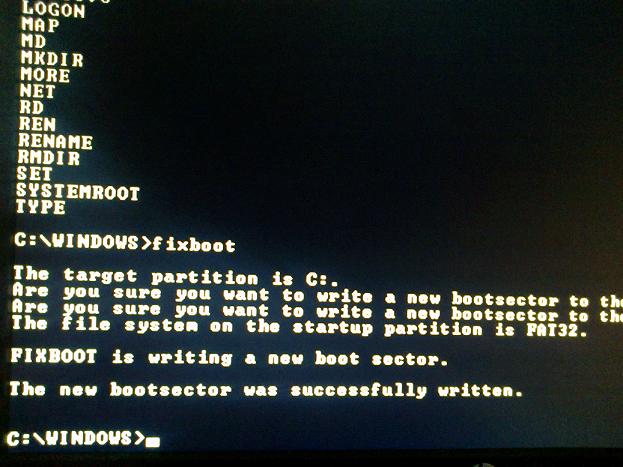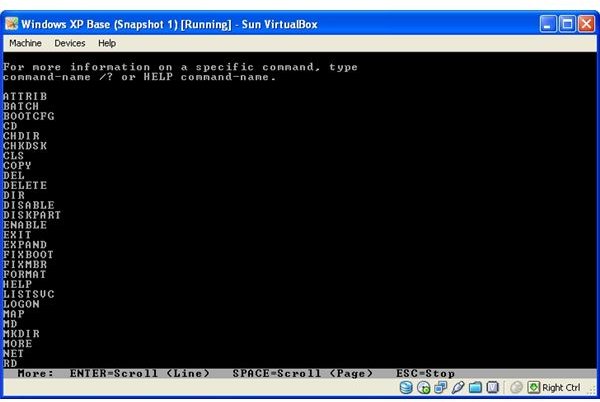
- Windows xp recovery console commands +map manual#
- Windows xp recovery console commands +map full#
- Windows xp recovery console commands +map windows#
These are the Bootcfg /Delete subparameters.Īs you can imagine, the subparameters for some of the other main parameters can be very detailed.
Windows xp recovery console commands +map full#
The full syntax for the Bootcfg /Delete parameter isīootcfg /Delete ] Each one of the Bootcfg command’s 11 main parameters has its own extensive set of subparameters that provide you with more control for fine-tuning the process of editing of the Boot.ini file.įor example, the /Delete parameter, which you can use to delete any existing boot entry in the Boot.ini file, has four additional subparameters (see Table C). Well, the answer is: they can’t do it alone. Another big advantage to the command line version of the Bootcfg command is that it allows you to remotely change the Boot.ini file on other computers on your network.Īfter reading through the list of Bootcfg parameters listed in Table B, you’re probably wondering how those few parameters will allow you to perform all the options listed in the description.
Windows xp recovery console commands +map manual#
For that reason, Microsoft designed the command line version of the Bootcfg command as a tool that you can use to automatically make the most common changes to the Boot.ini file without the need for manual editing of the file. The Bootcfg command was introduced because many folks manually editing the Boot.ini file were inadvertently introducing syntax errors to the file, which were further complicating problems. When you first learn about the existence of the command line version of the Bootcfg command, you may wonder why you’d want to use it in the first place since the Boot.ini file is simply an ASCII text file that you can easily edit in Notepad. Why use the command line version of Bootcfg? These are the Bootcfg command’s parameters for entry at the Command Prompt.

When you see the Welcome to Setup screen, shown in Figure A, press R to start the Recovery Console. Now, simply follow the prompts that will allow the loading of the basic files needed to run Setup.
Windows xp recovery console commands +map windows#
If it isn’t, find out about using Windows XP Setup Boot Disks here. If the system is capable of booting from the CD, follow the onscreen instructions to do so. To do so, insert the Windows XP CD and restart the system. Of course, using the Recovery Console version of the Bootcfg command means that you must first launch the Recovery Console. In this situation, you can use the command line version of the Bootcfg command. There are other times when a problem in the Boot.ini file is a subtle one that doesn’t cause major boot problems, but it needs to be fixed nonetheless. When the problem prevents Windows XP from booting up correctly, you’ll use the Recovery Console version of the Bootcfg command. However, that’s not always the best solution sometimes the Boot.ini file can be repaired. Many IT pros think the only solution to this problem is to start from scratch and reinstall the operating system. Often a problem rooted in the Boot.ini file can render Windows XP incapable of booting up correctly. When to use the Recovery Console and the command line As I do, I’ll take a look at both the Recovery Console and the command line versions of the Bootcfg command. In this Daily Drill Down, I’ll explain in detail all of the features and options that the Bootcfg command puts at your disposal. You need to have a solid understanding of how this tool works and when to use it.

This command can save you a lot of time and frustration when you need to edit the Boot.ini file. The Bootcfg command is available both as a stand-alone command line tool and as a part of the Recovery Console. Windows XP comes with a new tool designed to make it easier for you to configure and troubleshoot problems with the Boot.ini file. See how Windows XPs Bootcfg command can save you a lot of time and frustration when you need to edit the Boot.ini file.

Build Your Skills: Get to know Windows XP’s Bootcfg command


 0 kommentar(er)
0 kommentar(er)
